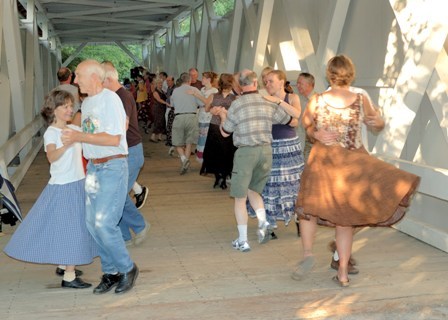Everett Road Covered Bridge

Passing by the Everett Road Covered Bridge, you can still hear the shuffle of feet moving to a lively tune. Both young and old come together at the bridge to share in a tradition passed down from the Cuyahoga Valley's first settlers from New England: the contra dance. Several times a year, friends and neighbors gather together to dance at historic locations near the Village of Peninsula. One of the most popular settings, the Everett Road Covered Bridge, allows dancers to connect to a tradition deeply rooted in the valley experience. Incredibly popular during the early 20th century, dances offered young men and women the rare opportunity to enjoy entertainment together. A local orchestra played while a caller announced instructions for the dances, which took place in nearby dance halls, or even in the street. The modern use of the Everett Bridge evokes these historic traditions of engagement with the local community.
The Everett Road Covered Bridge, which crosses over Furnace Run, is the only remaining covered bridge in Summit County. To take advantage of the Ohio & Erie Canal, and later railroads, valley residents needed roads. According to valley legend, the Everett Bridge was built in response to a local tragedy. In 1877, farmers John Gilson and his wife supposedly attempted to cross Furnace Run after melting ice made their usual ford impassable. Although Mrs. Gilson survived the stream, John Gilson's horse pulled him into the icy water where he soon drowned. Although historians concluded that the bridge was constructed in the late 19th century, its actual construction date remains unknown.
Nestled deep within the valley, the Everett community witnessed many changes since its beginnings in the 1820s. Visitors to the village in the 19th and early 20th century could cross Furnace Run through the covered bridge and enter a small neighborhood complete with a blacksmith, church, one-room schoolhouse, general store, saloon, dance hall, and railway station. After the establishment of the Cuyahoga Valley National Park, the Department of the Interior purchased and rehabilitated many properties in Everett. Despite the sense of loss that accompanied the demise of the lively Everett village, the Everett Road Covered Bridge and contra dance participants testify to the persistent sense of community in the valley.
Audio
Images




